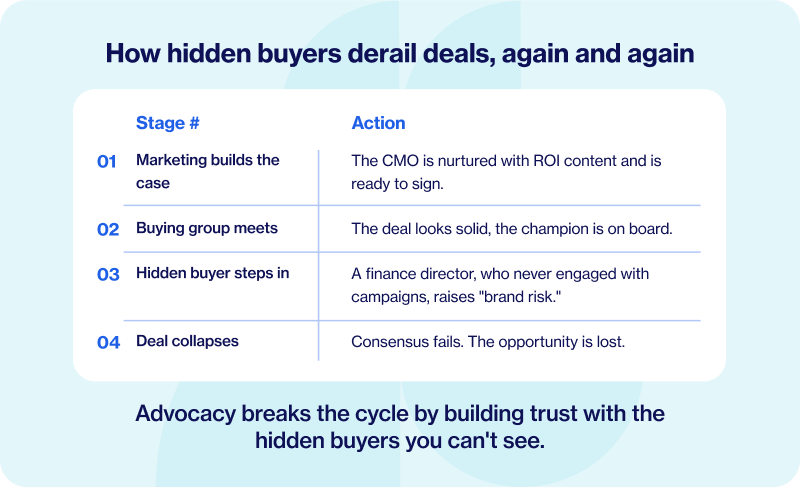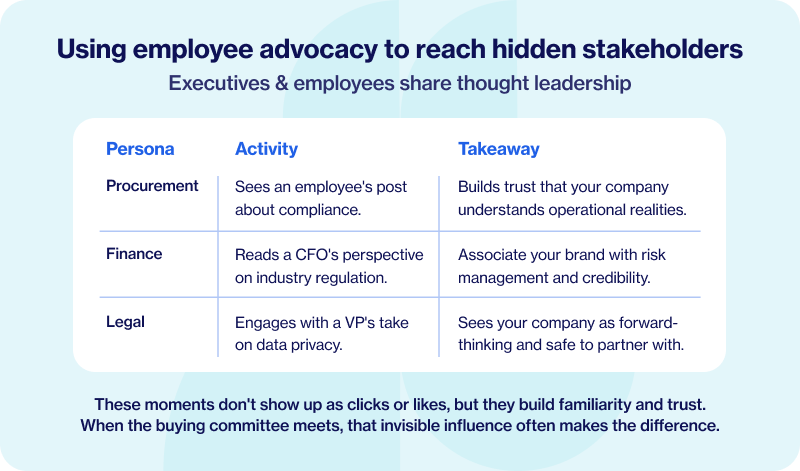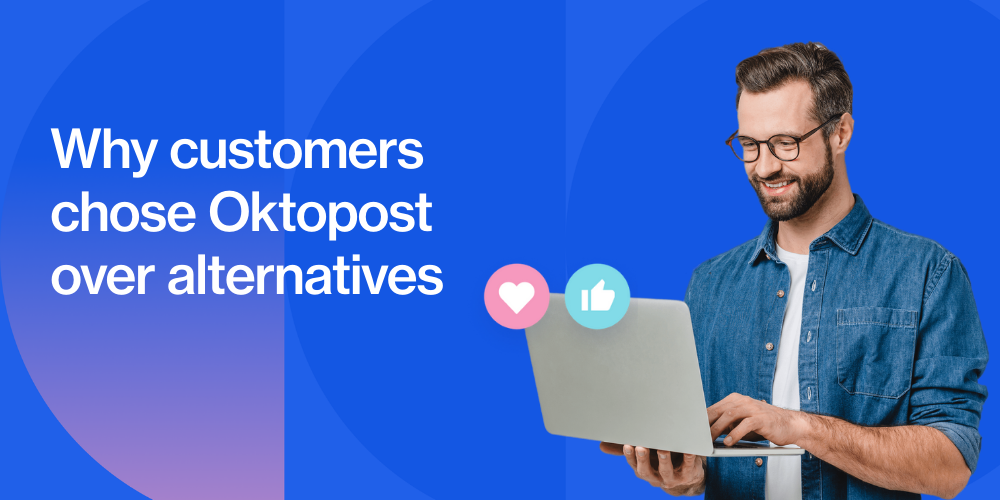How to influence hidden B2B buyers before they say “No”

Table of contents
- What are hidden buyers in B2B sales?
- Why do hidden buyers derail even strong pipelines?
- The priorities hidden buyers actually care about
- Why traditional marketing misses the mark
- Using employee advocacy to reach hidden stakeholders
- How Oktopost helps you influence hidden buyers
- The key takeaway: Visibility equals influence
You’ve done everything right. You nurtured the right decision-makers, delivered compelling content, and got on the shortlist. But then, the deal stalled.
Chances are, a stakeholder you never saw vetoed the decision. That’s frustrating, because these are people who don’t leave much of a trail. They haven’t clicked your ads or downloaded a whitepaper. They’re not showing up in your dashboards, but they’re in the room when the decision gets made.
Hidden buyers are why B2B deals collapse even when your visible pipeline looks strong. They’re the invisible audience shaping consensus, and they make or break outcomes far more often than marketers realize.
In this article, we take a look at who hidden buyers are, what they care about, and how B2B marketers can reach them by understanding the way they form opinions.
What are hidden buyers in B2B sales?
Hidden buyers aren’t a new phenomenon, but they’ve become far more potent as buying groups have expanded. Challenger research shows the average B2B buying group has more than doubled in size over the past decade. Once you involve six or more stakeholders, the chance of closing a deal drops to around 31%.
These stakeholders are often in functions that B2B marketing doesn’t target directly, such as finance, procurement, or legal. These are all functions that focus on risk, compliance, and cost. They may never interact with your content, but their signature is required for the deal to close. If they don’t trust you, they can stop progress cold.
It’s not just C-level vetoes, either. Senior directors in IT, operations, or purchasing can serve as hidden buyers. They may not be your primary users, but they’re responsible for integration, budget oversight, or compliance. They’re motivated by risk avoidance more than innovation.
Why do hidden buyers derail even strong pipelines?
Example: Your team spends months nurturing a CMO, building a bulletproof ROI case. The marketing leader is ready to sign. But in the final meeting, their CFO, who’s never engaged with a single campaign, kills the deal over “brand risk.” That’s the hidden buyer at work.
How hidden buyers derail deals, again and again |
||
|
Stage |
Action |
|
| 1. | Marketing and sales build the relationship | The CMO is nurtured with ROI content and is ready to sign. |
| 2. | Buying group meets | The deal looks solid, the champion is on board. |
| 3. | Hidden buyer steps in | A finance director, who never engaged with campaigns, raises “brand risk.” |
| 4. | Deal collapses | Consensus fails. The opportunity is lost. |
|
Advocacy breaks the cycle by building trust with the hidden buyers you can’t see. |
||

Recommended for further reading
The priorities hidden buyers actually care about
Target buyers and hidden buyers don’t weigh decisions the same way. Target buyers (your marketers, product managers, IT leaders) focus on innovation and ROI. They’re the people who care about the features and capabilities you’re offering. But hidden buyers tend to have different priorities. For them, reputation is at the top of the list. They need to know that a vendor is reliable, and they’re highly sensitive to trust signals.
Research from LinkedIn’s B2B Institute with NewtonX and Bain & Company shows:
- Hidden buyers are 70% more likely to reject brands that aren’t well-known.
- They’re 31% more likely to reject brands they personally don’t recognize.
- Their top drivers are reliability, peace of mind, and protection from risk, even if that means passing on innovation.
In other words, Target buyers want to know how your solution works. Hidden buyers want to know if your company is safe to bet on. And their influence is not symmetrical. Target buyers can recommend you, but hidden buyers can reject you. That single “no” can sink months of work.
A CIO may be convinced your platform is innovative and effective. But if the procurement director thinks your brand is too small, untested, or unknown, the deal stalls.
The cost of ignoring hidden buyers
The stakes couldn’t be higher.
- Roughly 40–60% of B2B deals collapse due to a lack of consensus.
- LinkedIn research shows 81% of successful deals were with brands known to “almost everyone” in the buying group. Only 4% closed when awareness was limited to a single function.
That means brand familiarity across the entire buying group is more important than price or product features. If hidden buyers don’t know or trust you, consensus fails.
You may never know why. A deal can disappear with no explanation because someone outside your field of view vetoed it.
Why traditional marketing misses the mark
Company pages are built for end users and product champions. They usually aren’t designed for risk-averse stakeholders, like those in finance or procurement. These hidden buyers probably aren’t following your brand channels. They’re also unlikely to engage with ads.
But they do notice the people they trust: executives, peers, and colleagues. These are the voices that tend to get their attention. On some level, we can all identify with this. You can probably name five executives whose posts you regularly read on LinkedIn. But naming a similar list of brand pages comes to most of us less naturally. Similarly, hidden buyers pay attention to leaders and employees who share their perspectives, rather than corporate logos, and post-campaign creative.
This is why traditional demand-gen strategies fall short. They target visible buyers but miss entirely the people in the back of the room. To convince them, you need a different set of tools.
Using employee advocacy to reach hidden stakeholders
When executives and employees share thought leadership, it pushes your brand into the feeds of networks you’d never reach otherwise. And those networks include the hidden buyers (procurement managers, finance leads, legal directors) who don’t follow you but do follow people they know.
- A procurement officer scrolling LinkedIn sees a post from one of your employees about compliance.
- A finance director notices your CFO’s commentary on an industry regulation.
- A legal stakeholder reads a VP’s take on data privacy.
These interactions don’t show up as likes, clicks, or downloads. But they are real nonetheless. Each time they happen, they build familiarity and trust. So when the buying committee meets to make a final decision, that invisible influence that’s been building all along can prove instrumental.
Using employee advocacy to reach hidden stakeholders |
||
|
Executives & employees share thought leadership |
||
|
Persona |
Activity |
Takeaway |
| Procurement | Sees an employee’s post about compliance | Builds trust that your company understands operational realities |
| Finance | Reads a CFO’s perspective on industry regulation | Associate your brand with risk management and credibility |
| Legal | Engages with a VP’s take on data privacy | Sees your company as forward-thinking and safe to partner with |
| These moments don’t show up as clicks or likes, but they build familiarity and trust. When the buying committee meets, that invisible influence often makes the difference. |
||

How Oktopost helps you influence hidden buyers
Reaching hidden buyers requires more than luck. It requires making advocacy systematic and scalable. It also requires having a reliable method to measure impact. Oktopost turns these challenges into a repeatable strategy.
- Advocacy Board makes it easy for executives and employees to share authentic content across their networks. This extends influence into those hard-to-reach, hidden buyer circles.
- Outreach integration equips sellers with thought leadership content inside their daily workflows, so influencing hidden buyers becomes part of everyday selling.
- CRM & LinkedIn profile analytics connect advocacy to the pipeline. With Oktopost, you can see how content shared by executives and employees influences opportunities. Crucially, you can do that even if the engagement wasn’t visible upfront.
The key takeaway: Visibility equals influence
Hidden buyers may already be reading your posts, even if they never like, comment, or click. Or, they may be hearing about you for the first time when an IT director puts your one-pager on their desk.
Either way, they’re forming impressions and inevitably weighing in on the decisions that matter most.
The only way to reach them is through the authentic voices they trust: your executives and employees. Advocacy builds the familiarity and credibility that hidden buyers demand. And with Oktopost, you can make that hidden influence measurable, repeatable, and directly tied to the pipeline.



